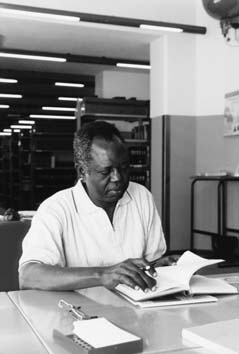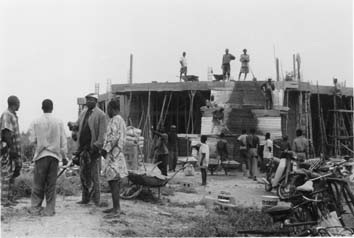Personal tools
News from ICTP 95 - Features - IMSP

Jean-Pierre Ezin, who has been associated with ICTP for more than two decades, describes how he hopes his Institut de Mathématiques et de Sciences Physiques will become a major regional math and physics centre in West Africa.
Into Africa

Jean-Pierre Ezin
When the first parcel of earth
was turned last spring to begin construction of a regional math
centre just outside Benin's capital city Porto-Novo, it marked
the end of a 25-year campaign for the construction of a regional
research and training facility in this small poor country on the
west coast of Africa. Jean-Pierre Ezin, a long-time visitor to
ICTP and head of the University of Benin's Institut de Mathématiques
et de Sciences Physiques (IMSP), has witnessed--indeed directly
participated in--the entire saga. In his own words, "the
ground breaking ceremony was a proud moment; now the real work
begins."
"I was a young post doctorate student at ICTP in the mid
1980s," explains Ezin, "when Abdus Salam asked me if
I would be interested in having ICTP support two or three students
when I returned to the University of Benin's math department to
resume my teaching responsibilities after a two-year hiatus in
Trieste."
"I was honoured by Salam's offer but I responded that the
creation of an independent centre, with its own research and training
responsibilities separate from the university's, might have a
greater long-term impact on the growth of mathematics in Benin.
To my surprise, Salam quickly concurred and assigned US$25,000
in the ICTP's budget to launch the effort. Salam also helped convince
the government of Benin to match ICTP's contribution." The
result was the creation of IMSP.
"The initiative, while modest, did fulfil some of the goals
both Salam and I had hoped for," says Ezin. "The first
US$25,000 grant from ICTP, given in 1989, turned into an annual
contribution that has continued to this day. Over the past decade,
the money has enabled us to enrol five students every other year
to participate in our advanced degree programmes in math and physics."
Additional periodic funding--for example, from Belgium, France
and Germany--has allowed the institute to raise its enrolment
at times to as many as 10 or 15 students. But it's ICTP's consistent
year-to-year funding, derived from the Centre's Office of External
Activities, that has given the Benin institute a firm foundation
from which it has developed into one of the most respected institutions
of its kind in Africa.
The institute was the first ICTP Affiliated Centre, an initiative
that has since become the centrepiece of ICTP efforts to work
jointly with universities and research centres in developing countries
to establish reputable in-country training and research facilities
serving local and regional scientific communities in a wide range
of disciplines. These centres, based on agreements between ICTP
and the host institutions, are found throughout the developing
world.
Today, there are six ICTP Affiliated Centres in Africa: IMSP in
Benin; a centre on semiconductors, solar cells and quantum physics
in Ethiopia; laser centres in Ghana and Sudan; and atomic physics
centres in Senegal and Cameroon. Each receives an annual grant
of about US$25,000 from ICTP.
The first class of five students at IMSP in Benin, all of whom
began in March 1989, attained their doctorates by 1994. All have
since gone on to successful academic careers. Isso Ramadhani,
who is from the Democratic Republic of the Congo, now teaches
at the University of Kinshasa, and Bernard Kamte, who is from
Cameroon, teaches at the University of Toronto. Meanwhile, the
institute's first three students from Benin have remained in their
home country--Jean Bio Orou Chabi and Joël Tossa are employed
at their alma mater and Taofick Adeleke at the Institut National
d'Economie. The 25 plus students who have followed in their
footsteps have achieved similar levels of success.
"We are not only pleased by our graduation rates, which have
been exceptionally high," explains Ezin, "but we are
proud that many of our graduates have continued to work in Africa--often
in their native countries--after attaining their degrees."
Ezin attributes this encouraging trend, which runs counter to
the 'brain-drain' effect that has sapped the strength of many
other like-minded initiatives, to the way in which his programme
has been structured.
"Our doctorate programme," he explains, "has always
followed the so-called 'sandwich' model: Students spend their
first year or two at IMSP, then move on to a university in the
North for a year or two, only to return to the University of Benin
to complete their course work and thesis. This way, students never
lose touch with IMSP. As a result, they are less likely to wind
up as professors or researchers in institutions in the developed
world."
IMSP works closely with a number of Northern universities and
research centres to ensure that the goals of its 'sandwich' programme
are met: for instance, in Belgium, the Université Libre
de Bruxelles; in Canada, the University of Toronto; in France,
the Université de Paris Sud in Orsay; in Germany,
the Max Planck Institute for Mathematics; and in the United States,
Florida State University. "All told," Ezin notes, "the
institute's sandwich programme involves more than a dozen institutions
in the developed world."
Overall, IMSP's track record of success has meant a great deal
to the math and physics community in Africa, where advanced training
and research facilities are in short supply and where many universities
do not even have a single math teacher with a doctorate degree
(see "Africa's
Future Discounted by Math Crisis," News from ICTP,
Summer 1998, p. 6-7).
Ezin and others who have been involved in the field for many years
have always realised that the number of doctorates that institutes
like his have been able to produce--some five Ph.D.s every other
year--are no match for the magnitude of the math and physics crisis
faced by Benin and other nations in Africa. "I don't want
to minimise our contribution," says Ezin, "but the truth
is our efforts have largely prevented a very bad situation from
getting much worse. We've never had sufficient resources to make
a great deal of progress. The best we've been able to do is to
prevent additional backsliding."
That may change, however, now that the government of Benin has
agreed to invest US$1 million for the expansion of IMSP. The new
support represents such a large increase--the institute's current
annual budget is just US$50,000--that, in effect, the allocation
sets the stage for the creation of a new institute different not
only in size but in scope from the facility that has preceded
it.
"This substantial infusion of funding," Ezin notes,
"should allow us to provide instruction for some 100 students
each year, not five every other year, which is the current situation."
To achieve this goal, Ezin anticipates that the number of faculty
will eventually increase from seven to 20.
"As our resources and size grow, so will the breadth and
depth of our curriculum," explains Ezin. "The institute
plans to offer courses in differential geometry, statistical physics,
functional analysis, control and game theory, and computer science.
We also plan to eventually build exchange programmes with other
math and physics institutions both in Africa and on other continents.
In fact, I have had preliminary conversations with colleagues
in Latin America that we hope will soon lead to some joint training
and research activities."

IMSP construction site
It's all part of an ambitious agenda that includes new classrooms,
a library, cafeteria, and guesthouse. "The goal is to build
a mini-ICTP-like facility designed primarily to serve the needs
of young mathematicians and physicists in West Africa," says
Ezin, who views what is happening "as an extension of Salam's
vision, which could never be completely realised until governments
in developing countries begin to invest in scientific research
and training effectively and sustainably."
So, after decades of coaxing and cajoling by Salam, Ezin and dozens
of others dedicated to the development of science in the South,
the Institut de Mathématiques et de Sciences Physiques
in Benin may soon emerge as an enduring symbol of their hard work
and dedication-and, more importantly, as an institution that helps
build a strong foundation in basic science that lifts the economic
and social well-being of the entire region.

IMSP construction site